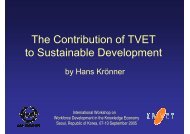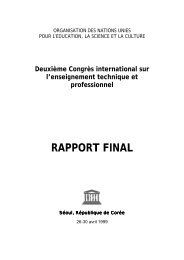Learning for Life, Work and the Future Initial ... - Unesco-Unevoc
Learning for Life, Work and the Future Initial ... - Unesco-Unevoc
Learning for Life, Work and the Future Initial ... - Unesco-Unevoc
You also want an ePaper? Increase the reach of your titles
YUMPU automatically turns print PDFs into web optimized ePapers that Google loves.
<strong>Learning</strong> <strong>for</strong> <strong>Life</strong>, <strong>Work</strong> <strong>and</strong> <strong>the</strong> <strong>Future</strong> Participants’ Papers Page 69<br />
sector or in individual private-sector institutions. The<br />
CEO lives at <strong>the</strong> cutting edge <strong>and</strong> has to steer with<br />
extreme care to keep on course <strong>and</strong> to see that <strong>the</strong><br />
country is <strong>the</strong> winner. According to Warren Bernis<br />
<strong>and</strong> James O’Toole in ‘Don’t Hire <strong>the</strong> Wrong CEO’,<br />
Harvard Business Review, May-June 2000, he needs<br />
to:<br />
• Have competence in TVET <strong>and</strong> human resource<br />
development<br />
• Demonstrate integrity<br />
• Provide meaning to <strong>the</strong> partnership<br />
• Generate trust<br />
• Communicate values.<br />
What determines high-per<strong>for</strong>ming CEOs is not who<br />
<strong>the</strong>y are, nor what <strong>the</strong>y say, but what <strong>the</strong>y do.<br />
It is not easy to find such people. In <strong>the</strong> absence of<br />
such qualities in <strong>the</strong> CEO, <strong>the</strong> Management Council<br />
(usually known as Board) does not receive proper<br />
guidance <strong>and</strong> <strong>the</strong> Council members ‘each drive <strong>the</strong>ir<br />
own cars <strong>and</strong> in different directions!’ The vision is lost<br />
<strong>and</strong>, ultimately, co-ordination <strong>and</strong> implementation of<br />
<strong>the</strong> different activities becomes blurred. Under such<br />
circumstances it becomes very difficult <strong>for</strong> donors to<br />
have a clear signal of <strong>the</strong> direction given to TVET <strong>and</strong><br />
<strong>the</strong>ir participation does not lead to <strong>the</strong> expected goals.<br />
Various alternatives are being tried in different<br />
countries to make <strong>the</strong> collaboration more successful.<br />
However, <strong>the</strong>re is no substitute <strong>for</strong> clear vision, commitment,<br />
dedication, <strong>and</strong> <strong>the</strong> will to succeed.<br />
8. Conclusion<br />
During <strong>the</strong> last decades, attempts have been made to<br />
promote <strong>the</strong> development of TVET in many developing<br />
countries. Great ef<strong>for</strong>ts have been deployed to<br />
obtain <strong>the</strong> participation of <strong>the</strong> private sector as well as<br />
donors. Experience shows that donor intervention has<br />
been successful where <strong>the</strong>re is a clear vision <strong>and</strong> when<br />
those at <strong>the</strong> decision-making levels are top-level CEOs<br />
from both public <strong>and</strong> private sectors. This partnership<br />
provides high-quality decisions <strong>for</strong> <strong>the</strong> development of<br />
TVET <strong>and</strong> <strong>for</strong> human resource development in <strong>the</strong><br />
country. In addition, <strong>the</strong> calibre of <strong>the</strong> CEO largely<br />
determines <strong>the</strong> success or failure of <strong>the</strong> collaboration<br />
amongst <strong>the</strong> different stakeholders, including <strong>the</strong><br />
donors.<br />
19 MUPANGA, S<strong>and</strong><strong>for</strong>d A. (Zambia): Access to TVET – A Case <strong>for</strong> Zambia<br />
1. Introduction<br />
Zambia has a population of more than 11.4 million.<br />
The country has only two universities <strong>and</strong> twenty-three<br />
government-owned technical <strong>and</strong> vocational education<br />
<strong>and</strong> training (TVET) institutions. There are, of course,<br />
a number of non-<strong>for</strong>mal training institutions. Access to<br />
TVET institutions is a big problem <strong>for</strong> many Zambians<br />
who, <strong>for</strong> a number of reasons, are unable to enter<br />
TVET systems.<br />
2. Equipment <strong>and</strong> Infrastructure<br />
In Zambia, <strong>the</strong> Ministry of Science, Technology <strong>and</strong><br />
Vocational Training (MSTVT) runs <strong>the</strong> <strong>for</strong>mal TVET<br />
institutions, <strong>and</strong> o<strong>the</strong>r Ministries also run a number of<br />
non-<strong>for</strong>mal training institutions.<br />
The institutions under <strong>the</strong> Ministry of Science, Technology<br />
<strong>and</strong> Vocational Training train craftsmen/<br />
women, technicians <strong>and</strong> technologists. The duration of<br />
craft courses is two years, with no industrial attachment.<br />
For technicians, it is two-<strong>and</strong>-a-half years<br />
inclusive of industrial attachment, <strong>and</strong> <strong>the</strong> diploma<br />
course <strong>for</strong> technologists takes three-<strong>and</strong>-a-quarter<br />
years, again inclusive of a period of attachment to<br />
industry. In most of <strong>the</strong>se instituitions, <strong>the</strong> tools <strong>and</strong><br />
equipment are obsolete except where donors have<br />
rendered assistance. Access is <strong>the</strong>re<strong>for</strong>e limited due to<br />
inadequate tools <strong>and</strong> equipment/infrastructure.<br />
It is important to mention here that <strong>the</strong> reservoirs <strong>for</strong><br />
<strong>the</strong> TVET institutions are <strong>the</strong> secondary schools, of<br />
which <strong>the</strong>re are many. It has proved impossible to<br />
admit all eligible students to <strong>the</strong> TVET institutions.<br />
3. Facilities <strong>for</strong> Delivery<br />
The facilities <strong>for</strong> delivery of TVET programmes have<br />
been mainly <strong>the</strong> institutions, which have been offering<br />
full-time programmes. Students are required to attend<br />
classes from morning to afternoon. The number of<br />
students admitted is dependent on <strong>the</strong> rooms available<br />
at a given institution since <strong>the</strong>y are <strong>for</strong> <strong>the</strong> most part<br />
boarding institutions. But it is interesting to note that<br />
this trend is changing, as many students are encouraged<br />
to be day scholars.<br />
At <strong>the</strong> level of Craft, Technician <strong>and</strong> Technologist,<br />
<strong>the</strong>re are also part-time students who follow <strong>the</strong> TVET<br />
courses over a longer period of time than <strong>the</strong> full-time<br />
students, <strong>and</strong> receive <strong>the</strong> same certificates <strong>and</strong><br />
diplomas. Most of <strong>the</strong>se work during <strong>the</strong> day. It is a<br />
pity that as of now <strong>the</strong>re are no o<strong>the</strong>r facilities <strong>for</strong><br />
delivery of <strong>the</strong> programmes at <strong>the</strong> three levels in <strong>the</strong><br />
country.<br />
4. Access <strong>and</strong> Opportunity<br />
As stated in <strong>the</strong> 1996 Policy on Technical Education,<br />
Vocational <strong>and</strong> Entrepreneurship Training (TEVET),<br />
access to TEVET is open to all Zambians including





